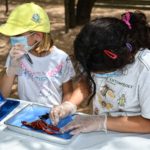Children learn about insects, science at Summer Bug Camp
AgriLife Extension entomologist has been putting ‘science bug’ in kids’ ears for 10 years
Writer: Paul Schattenberg, 210-859-5752, paschattenberg@ag.tamu.edu
Contact: Molly Keck, 210-631-0400, mekeck@ag.tamu.edu
SAN ANTONIO – For the past 10 summers, a Texas A&M AgriLife Extension Service entomologist has been sharing her love of insects, nature and science with Bexar County youth.
“Each summer we conduct three regular Summer Bug Camps for kids ages 7-12 along with a junior entomology camp for kids 4-6 years old,” said Molly Keck AgriLife Extension integrated pest management specialist, Bexar County. “The regular camps are from 9 a.m. to 2 p.m. over a three-day period and the junior camps are usually for a few hours over a few days.”

The regular camps are usually in the Urban Ecology Center at Phil Hardberger Park in northwest San Antonio, while the junior camps are typically at the AgriLife Extension office or at Keck’s home.
The camps are always full and attendance is limited to about 25 to ensure personal attention and adequate help with hands-on activities. Participants are supplied with insect collection kits, including a net, insect sample containers and a box for display.
“There are usually as many girls as boys in the camps, and we have plenty of youth and adult camp helpers to ensure the participants get individual attention,” Keck said. “The camps are also a good venue where ‘girls who like bugs’ can share that interest and everyone can learn about entomology and related subjects.”
Nicolas Phillips, 20, has been a camp helper since 2010.
“I became a camp helper to learn more about entomology and to learn how to teach kids about entomology and science,” Phillips said. “Learning how to teach kids has been a fun experience for me, and I’ve learned a lot from Molly. I plan to become a forensic entomologist, and this experience has taught me a lot.”
In addition to class instruction, the camps provide many outdoor, hands-on activities to keep participants engaged and interested.

“We do insect-related experiments and activities, and each day we go out and capture insects,” Keck said. “This gives the kids a chance to be outdoors and get some exercise while learning. And one of the best takeaways from the class is they get to net and gather bugs to make their own amateur bug collection.”
Keck said camp activities often use the theme of a particular insect, but its overall focus is on insects in general and their importance to the ecosystem.
“We’ve previously had classes featuring termites and beetles, and this year’s theme was crickets,” Keck said.
Ellie Gold, 9, has attended Summer Bug Camp for the past two years. She enjoyed learning about crickets at the camp.
“We learned a lot about crickets and how high they can jump and how to tell a male cricket from a female,” Gold said. “And we also got to learn about other bugs, like millipedes. I like the way insects feel on your hands. Insects are very interesting.”
In keeping with the cricket theme, campers also raced robot models shaped like crickets.
Another hands-on activity at the camp is called Life in a Rotting Log. For this activity, participants are separated into small groups and each group is provided a transparent plastic container holding rotting wood, soil and other organic material. The participants dig through the containers to locate and identify the insects serving as decomposers in the small ecosystem.

“The kids usually find beetles, centipedes and millipedes in the containers, and let them crawl over their hands,” Keck said. “We ask them to be careful with the insects and not harm them. This helps us reinforce that they should have respect for the insects and the role they play in the environment. We want them to understand that almost all insects are beneficial and serve a purpose in our ecosystem.”
Jack Matthews, 13, has been attending Summer Bug Camp for the past eight years — first as a participant and then as a helper. Matthews said he enjoys learning how entomology intersects with math and science.
“Insects can be used to help us advance medicine and defeat diseases,” Matthews said. “I like math and science and you get to apply some of both in bug camp.”
Kaelyn Holland, 7, who attended camp for the second time this year, enjoyed participating in the Bess Beetle Pull, an exercise in which participants find out how many pennies a beetle can pull over a flat surface.
“It was fun to see how strong the beetles were,” Holland said. “We put pennies into a plastic dish and the beetles pulled as many as they could. Then we figured out how many pounds that would be for a human to pull.”

Another popular hands-on activity at bug camp is dissection. This year, students were paired up, given surgical masks and scalpels, and provided instruction on how to properly dissect both giant grasshoppers and crawfish.
“We let the students know the grasshoppers and crawfish have been preserved in formaldehyde so they could learn about their anatomy and about the difference between an insect and an arthropod,” Keck said. “This exercise also helps them with their concentration and hand-eye coordination as they study insect anatomy.”
Keck noted bug camp instruction and activities are designed to help meet state-mandated Texas Essential Knowledge and Skills requirements, but their primary goal is broader.
“The main goal of these bug camps is to help youth learn why insects are important, to develop a respect for nature and the environment and to show that science doesn’t have to be daunting – in fact, it can be pretty fun,” she said.


